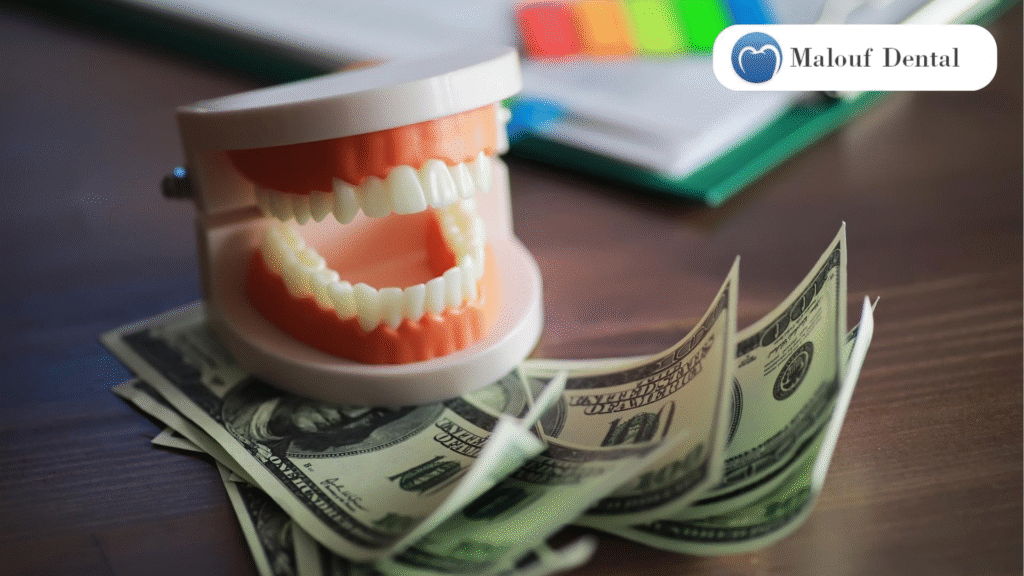Dental Crowns vs Veneers: Which Is Right for You?

You want to fix a damaged or uneven tooth, but which option works best? A dental crown? A veneer? These are common questions we hear at MaloufDental. It all depends on the condition of your tooth and what you’re hoping to improve. Maybe you want it to look better, feel stronger or do both.
Crowns and dental veneers both help with restoring teeth, but they do very different things. One offers strength. The other offers a cosmetic upgrade. Understanding this difference is the first step to making a choice you won’t regret.
In this guide, we’ll compare the two, show you real differences in cost, durability and purpose, and explain which option suits which situation. We’ll also share what to expect before and after treatment so there are no surprises.
Want to feel more confident in your decision? You’re in the right place. Let’s get into it.
What Dental Veneers Can Do for Your Smile
Dental veneers are a great option when you want to change how your teeth look without diving into major dental work. These are thin shells that go on the front of your teeth, helping with colour, shape or spacing. They’re common in dentistry for people who want a more even, brighter smile.
How dental veneers shine:
- They cover stains that whitening can’t fix
- They fix chips or slightly crooked teeth
- They make your smile look more even overall
Think of veneers like a fresh coat of paint for your smile. Only this one stays on when you eat pizza. They’re designed to look good, feel comfortable and hold up well over time. As they’re custom-made and carefully fitted, the price in Australia usually starts around $1,000 per tooth. The final amount depends on what material is used and how much prep your teeth need.
Here’s a breakdown of the materials:
Composite resin
This type is shaped and applied right onto your tooth during the same visit. It’s great for smaller fixes and costs around $1,000 to $1,400 per tooth. It’s quick and more affordable, but it doesn’t last as long as other options. Dentists often recommend it if you’re trying veneers for the first time or planning a short-term improvement.
Porcelain
Porcelain veneers are made in a dental lab before they’re bonded to your teeth. They tend to fit better and look more natural. They cost around $1,800 to $2,500 per tooth.
Many people say they feel just like real teeth. They also reflect light like enamel, which helps the finish blend in nicely. Plus, they are more resistant to chips and stains, which makes them a better pick for the long run.
The Australian Dental Association has found that more people are choosing cosmetic treatments like veneers to feel better about their smile. And, when a simple fix can boost your confidence every time you look in the mirror, it’s easy to see why.
Let’s talk about crowns next and why they might be the better call in some cases.
Types of Dental Crowns and Their Costs
A crown is like a custom helmet for your tooth. They help with chewing, speaking and smiling without worry. If the tooth underneath is weak, cracked or heavily filled, a crown keeps it safe and working well. It wraps the whole tooth, not just the front, giving it strength from all sides.

Here are some common types of dental crowns for teeth:
- Metal (like gold): Gold crowns are strong and built to last. Dentists often use them on molars that do the heavy chewing. They hold up well and rarely crack or chip. The shiny look isn’t for everyone, but they’re great for the teeth at the back. Prices usually start around $1,600 per tooth.
- Porcelain-fused-to-metal (PFM): These give you strength with a more natural look. There’s a metal base underneath and porcelain on top. They work for both front and back teeth. Over time, the metal might show at the edge. They cost about $1,400 per tooth and offer a good mix of function and appearance.
- Zirconia: Zirconia crowns are known for being both tough and good-looking. They can handle pressure well, so they’re a solid choice if you grind your teeth. People often choose them for their strength and natural finish.
- All-ceramic: Want the most natural look? All-ceramic crowns are designed to blend in perfectly with your other teeth. They’re metal-free, which is ideal for people with allergies or metal sensitivities. They’re best for front teeth, where appearance matters most. Prices start from $1,300 per crown.
Each crown type has its place. The best one for you depends on where the tooth sits, how much pressure it takes and how natural you want it to look. Along with these factors, it also helps to know what support you might get from your health fund.
If your crown is medically needed (for example, after a root canal), many Australian health funds offer partial cover under extras policies. But, be sure to check for waiting periods and annual limits.
Now that you’ve seen the types and price ranges, let’s figure out how long these treatments last and what matters when choosing between cosmetic and functional fixes.
Cosmetic vs Functional: Which Fix Lasts Longer?
You don’t always need to choose between how your smile looks and how it works. If your tooth is healthy but you’re not happy with how it looks, cosmetic options like veneers work well. But if it’s damaged, worn or weak, you’ll want the full protection that crowns provide.
So, how long do they last?
- Veneers usually last 10 to 15 years with good care
- Crowns can last 15 to 20 years or more, especially with proper cleaning and check-ups
Pro tip: If you clench your jaw or grind your teeth while you sleep, tell your dentist. A crown might be the safer choice. In some cases, wearing a night guard will help protect your new tooth and make it last longer.
From our experience, picking the right option early on saves you trouble later. Some patients who chose veneers for minor fixes came back happy years later. Others who needed more support went with crowns and felt peace of mind knowing the tooth was secure.
Making the Right Choice for Your Smile at Malouf Dental
Both crowns and veneers can do amazing things for your teeth. What matters most is picking the one that fits your needs. If your tooth is healthy but could use a cosmetic lift, veneers might be the way to go. If the tooth is weak or damaged, a crown will give it strength and help you avoid bigger problems down the line.
We’ve talked about how long each option lasts, what they cost and when each one works best. It really comes down to your smile, your goals and your comfort.
If you’re still deciding, don’t guess. Talk to your dentist, ask questions and get a treatment plan that feels right to you.
And if you’re ready to have that conversation now, we’re here to help. We take the time to listen and guide you toward the right option for restoring teeth that look and feel just right.





